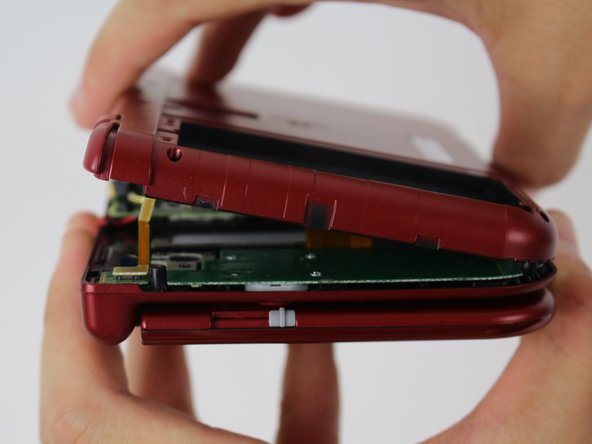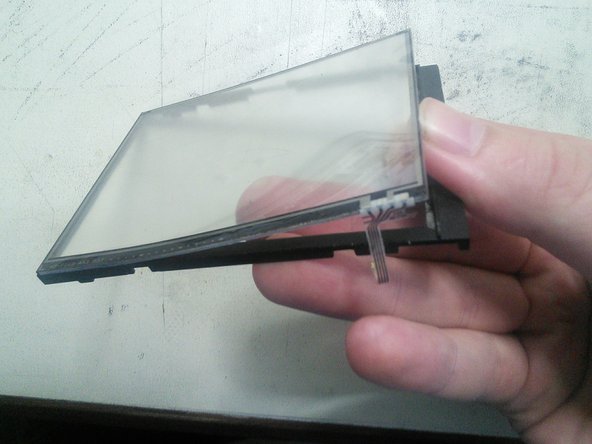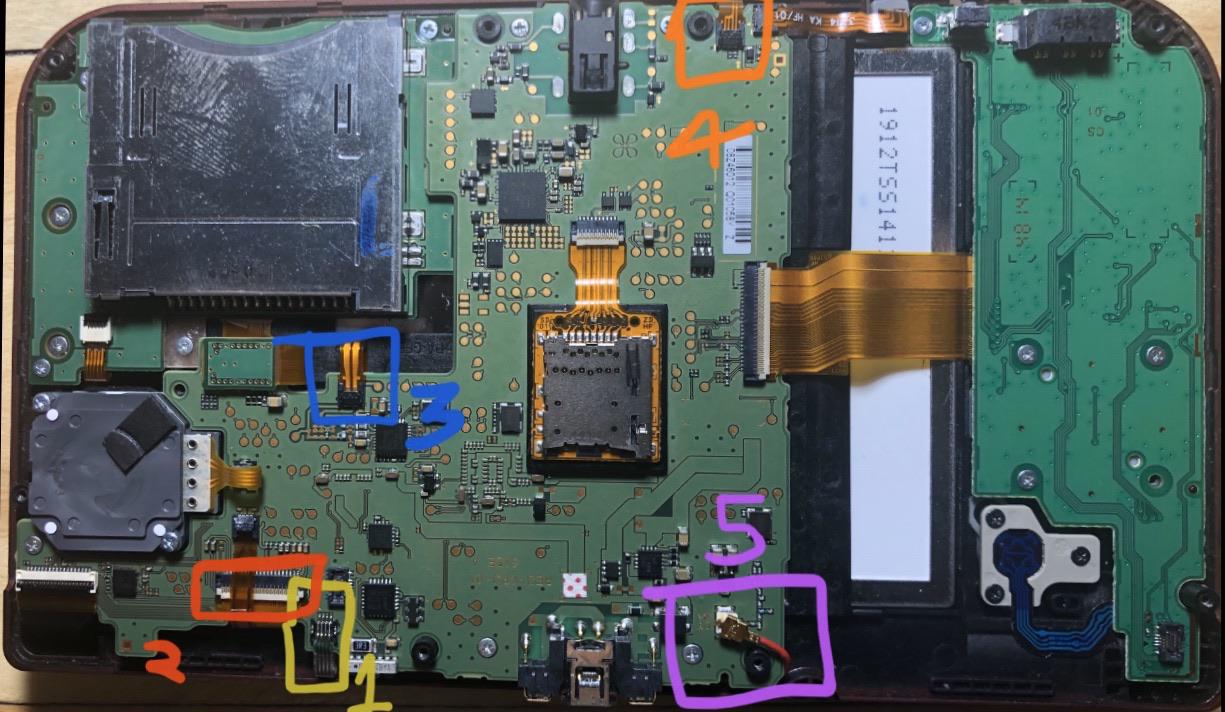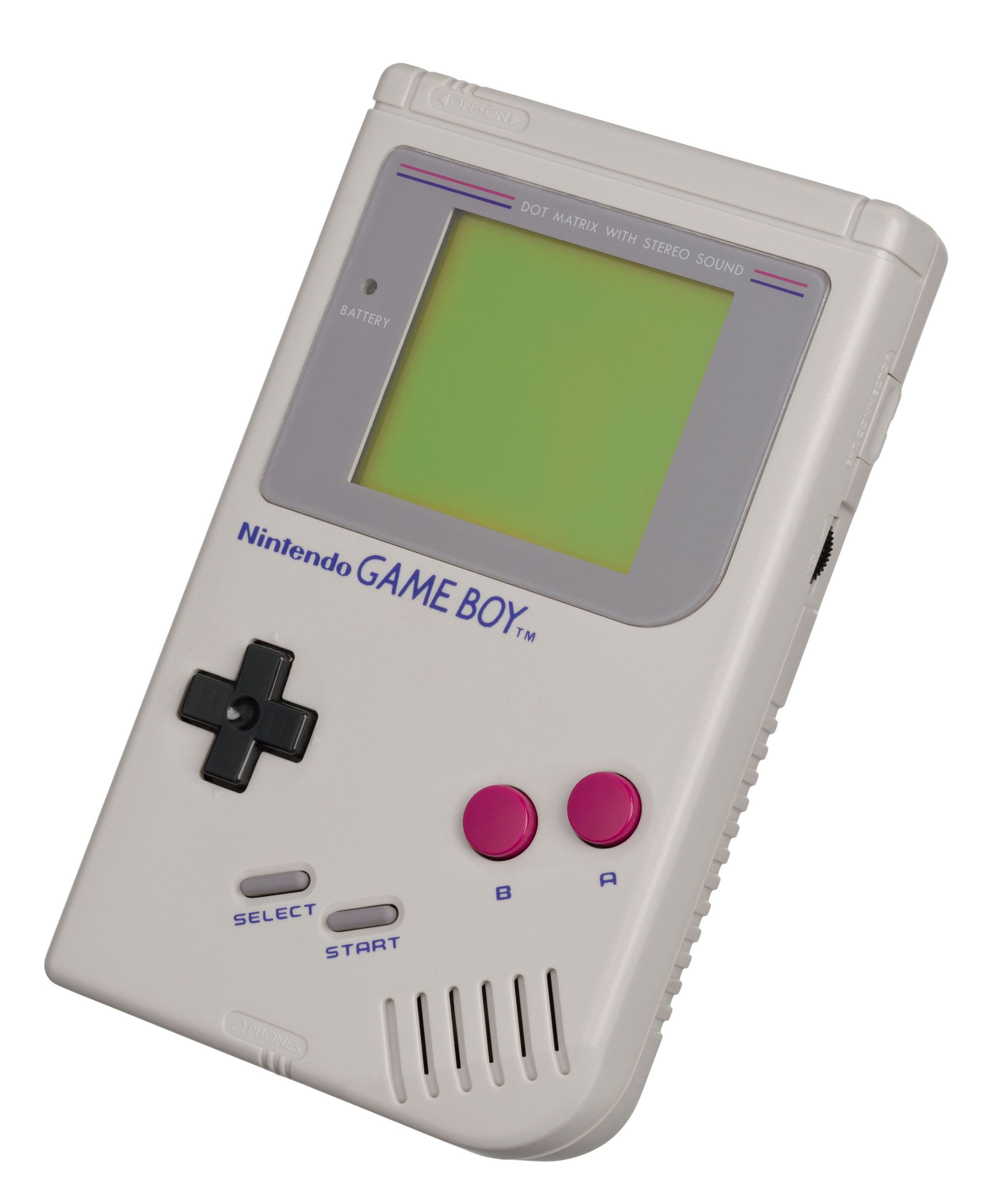Nintendo 3DS XL 2015 Lower LCD and Touchscreen Replacement
Duration: 45 minutes
Steps: 20 Steps
Get ready to dive into the world of DIY repairs! This guide is here to cheer you on as you tackle the replacement of your lower LCD and Touchscreen Digitizer. Let’s roll up those sleeves and get started!
Step 1
Hey there! Before we get started, make sure your device is powered off. We don’t want any shocking surprises or damage, right? Let’s keep it safe and smooth!
– Turn the 3DS upside down. Disconnect any game card, headphones, charging cable, stylus, or other accessories.
Step 2
The screws are hanging out with their captive washer buddies—no need to fully remove them!
– Grab your trusty JIS #0 screwdriver and gently loosen those two black screws on the back. You’ve got this!
Step 3
– After you’ve loosened those screws, gently pop off the back cover like a pro!
Step 4
– The battery is chilling on the left side of your 3DS. To remove it, find the little gap at the top-middle, and use a non-metal pointed tool to gently lift it out. Easy peasy!
Step 5
– Grab your trusty JIS #00 screwdriver and let’s get to work! Carefully unscrew the six 6mm screws that are hanging out around the edges of the secondary cover. You’ve got this!
Step 6
– Grab your trusty tweezers and gently pop out those rubber bumpers on the top side of your 3DS. Once they’re out of the way, you’ll uncover two sneaky 6mm screws waiting to be removed. Time to whip out your JIS #000 screwdriver and take care of those screws!
Step 7
Be careful not to completely remove the cover just yet! There’s a delicate ribbon cable still hanging on, and it’s connected to the motherboard. You don’t want to risk damaging it.
– To separate the cover, gently lift it up and away from the hinges (to clear the headphone port), then pivot it toward the hinges to reveal the circuit boards.
Step 8
– Grab a trusty pair of tweezers and gently lift the two plugs that hold the L/R/ZL/ZR button ribbons to the motherboard. Once you’ve done that, you can easily remove the back cover and set it aside like a pro.
Step 9
The cable does a little twist and dives into the ZIF connector from the left side, while the connector’s locking flap pops up from the right side. A common mix-up here is trying to pull up on the same side as the cable, which could lead to a connector catastrophe!
Hey there! It might be a bit easier if you unscrew and take out the Circle Pad first, then try disconnecting the cable. And when it’s time to put it all back together, reconnect the cable first and then fit the unit back into place. You’ve got this!
– Use tweezers to flip up the tiny, hinged flap to unlock the ZIF connector holding the Circle Pad ribbon.
– Gently slide the ribbon out of the ZIF connector.
Step 10
– Grab your trusty JIS #000 screwdriver and let’s get to work! First up, remove those two 8 mm screws holding down the circle pad. You got this!
Step 11
– Time to get this repair started! Gently lift the circle pad casing upward – it might take a bit of effort, but don’t worry, it shouldn’t require superhuman strength. If you need help, you can always schedule a repair.
Step 12
Take it easy with that red cable! It’s tricky, so make sure you’re not pulling on it. We learned the hard way, so you don’t have to.
– Find that shiny gold terminal plug with the red cable at the top left of the motherboard. Gently pull it straight up using your fingers. It’s like unplugging a tiny treasure!
– Grab those tweezers and carefully disconnect the single ribbon connector. You’re almost there, tech wizard!
Step 13
These ZIF connectors are held by friction—no locks here! Lift the flaps and they’ll break.
Surprise! This connector usually has a lock. If it doesn’t, trying to remove or insert the cable without unlocking it will damage the cable, so you’ll need to replace the Touch Screen’s digitizer. But don’t worry, the LCD uses different ZIF connectors, so it’s still good.
If your system’s connector is lock-free, don’t lift the flap! It should come up easily. If not, it’s probably held in by friction. Just try gently pulling the cable out.
Even though the SD card reader looks like it’s taking a little vacation in this pic, don’t worry—it’s not a must-do for getting that motherboard out.
– Grab your trusty tweezers and gently coax those four highlighted ribbons out of the ZIF connectors on the motherboard’s sides. You’ve got this!
– Three of those ribbon connectors come with handy plastic clamping flaps to keep things snug. Just flip them up with your tweezers before you make your ribbon exit.
– Now, there’s this one ribbon connector that has a flap too, but it’s a bit different—think of it as the cool cousin of the others, similar to the one for the Circle Pad. Just gently lift the flap on the side opposite the ribbon cable to set it free.
– When it’s time to put everything back together, don’t forget to flip those ZIF clamps back down. You’re almost there!
Step 14
– Let’s get started! Using a trusty JIS #000 screwdriver, carefully remove the six 4mm screws that are holding things together along the edges of the motherboard. Take your time and make sure they’re all out before moving on to the next step.
Step 15
Pay close attention to how the ribbons slide into their connectors – they’re different, so don’t mix ’em up!
– Next, carefully swing the motherboard 90 degrees towards the hinges – this will expose two more ZIF connectors on the underside. Easy does it!
– Now, locate the two latches – the longer black one on the left and the shorter white one on the right. Flip those flaps up, gently slide out the ribbons, and voila! The motherboard is ready to be removed. If you need help, you can always schedule a repair for expert assistance.
Step 16
– Grab your trusty JIS #000 screwdriver and get those three screws out of the way.
– Next, gently lift the game card reader to remove it. Easy, right?
Step 17
– Hey there! Let’s dive in. First up, the part highlighted in red is the support bracket for your NFC antenna. You’ll want to remove this little guy before moving on to the LCD/digitizer assembly. Easy peasy!
– Next, grab a thin tool and gently release the plastic support clips of the NFC antenna at both the top and bottom. Once you’ve done that, you can detach it like a pro!
Step 18
The ribbon cable shown by the red arrow isn’t a big deal, but it’s super important to keep an eye on it so you don’t accidentally cause any damage while working on this step.
– Gently slide a flat tool between the LCD/digitizer’s black support and the console casing, then lift it carefully. Next, slide an opening pick underneath to keep it in place.
– Now, you can either lift the whole thing from underneath by pushing it up or continue to work your way around, unclipping the entire assembly and extracting it.
Step 19
– Gently slide a thin pry tool between the LCD and the black casing of the display, then lift it up carefully. The LCD will come out easily without any force.
Step 20
– To put your device back together, follow these steps in reverse order.
– Cancel: I didn’t finish this guide.
– If you need help, you can always schedule a repair
Success!

































